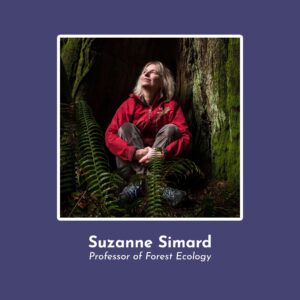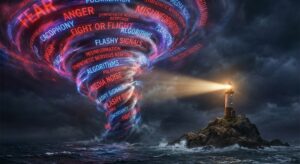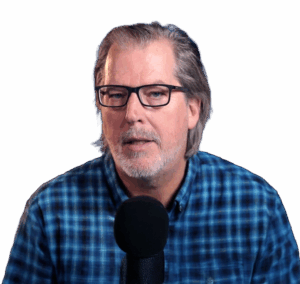
Ep 143 | Suzanne Simard
Suzanne Simard: “Rooted in Connection: Exploring the Hidden Ties in Earth’s Forests”
Show Summary
Humanity’s relationship with Earth’s forests is long and complex. While some societies have preserved their understanding of the intricate connections within woodland ecosystems, others have lost sight of their importance as modern life has deepened the disconnect between humans and nature. How is science helping our modern, industrial culture reconnect with the intricate relationships that build Earth’s invaluable forests?
In this episode, Nate welcomes forest ecologist Suzanne Simard to explore the forces that shape forest ecosystems, from the critical role of biodiversity in nutrient dispersal among tree species to the worrisome implications of the monoculture and clear-cutting practices common in the timber industry.
What are the effects of extractive forest management techniques on trees that rely on cross-species networks to survive and thrive? How do indigenous societies, who have long understood these relationships, exist symbiotically with these magical ecosystems? What else does science not yet understand about forests that might help us navigate the ecological strain we’ve put on the biosphere?
About Suzanne Simard
Suzanne Simard is a Professor of Forest Ecology at the University of British Columbia and the author of the book, Finding the Mother Tree. She is a pioneer on the frontier of plant communication and intelligence and is known for her work on how trees interact and communicate using below-ground fungal networks, which has led to the recognition that forests have hub trees.
With over 200 peer-reviewed articles, Suzanne’s current research investigates how these complex relationships contribute to forest resiliency, adaptability, and recovery and has far-reaching implications for how to manage and heal forests from human impacts, including climate change.
In French, we have a motto that says that a simple drawing is often better than a long explanation. Jean-Marc Jancovici Carbone 4 President
That’s very understandable because with left atmosphere thinking, one of the problems is that you see everything as a series of problems that must have solutions. Iain McGilchrist Neuroscientist and Philosopher
We can’t have hundreds and hundreds of real relationships that are healthy because that requires time and effort and full attention and awareness of being in real relationship and conversation with the other human. Nate Hagens Director of ISEOF
This is the crux of the whole problem. Individual parts of nature are more valuable than the biocomplexity of nature. Thomas Crowther Founder Restor
Show Notes & Links to Learn More
Download transcript00:00 – Suzanne Simard info + works, book: Finding the Mother Tree
03:24 – Faculty of Forestry, University of British Columbia
04:25 – The Kootenays
07:49 – Timber harvests over time in British Columbia (BC) + clearcuts in BC
08:54 – Remaining old growth forests in BC
11:21 – First experiment on the transfer of nutrients between trees
11:41 – Ministry of Forests BC
16:08 – Mycorrhizal networks + paper on mycorrhizal networks
16:14 – The Mother Tree research project
17:11 – Mycorrhizas
18:20 – Multilevel Selection Theory + more info
20:02 – Pseudomonas fluorescens
24:00 – Mycorrhizal networks and tree communication
24:55 – Mycorrhizal fungi and the transfer of carbon + species-effects of different mycorrhizal fungi
27:25 – Trees grow by *2.5% per year
27:49 – Monoculture plantations in Spain + mixed-species vs monocultures in plantation forestry
28:29 – Eucalyptus monocultures + more info
31:10 – Wildfires + wildfires in Canada factsheet
33:16 – Impact of global warming on wildfires + more info
34:44 – IPCC climate projections
35:25 – We have lost 50% of primary forests + more data
36:00 – Forests are home to 80% of terrestrial biodiversity
36:15 – Deforestation and carbon storage
36:25 – Land use change accounts for 25% of carbon emissions + more info
40:39 – The Amazon as a carbon source
41:00 – The biotic pump, tipping points in the Amazon
41:32 – Anastassia Makarieva on the biotic pump theory
41:54 – The water cycle in the Amazon
42:27 – Hydraulic lift
45:50 – Indigenous people safeguard 80% of the world’s remaining biodiversity (**this statistic is disputed)
46:28 – The Mother Tree
48:07 – Kapok tree
49:26 – Epigenetic variation of trees in response to climatic changes
51:48 – Shinrin Yoku (forest bathing)
54:27 – Neural networks
57:51 – Carbon sequestration of old-growth forests, old-growth logging in BC,
58:15 – Research on logging and carbon emissions
1:00:12 – Energy efficiency of biomass compared to coal + more info
1:00:45 – Biofuels and deforestation
1:01:22 – Evaluation of Drax’s carbon footprint
1:03:25 – CO2 emissions embodied in trade







